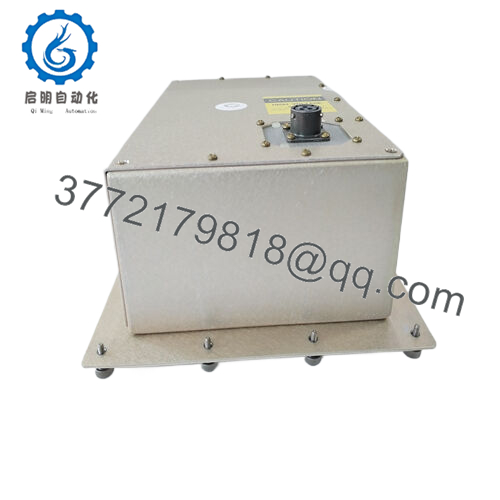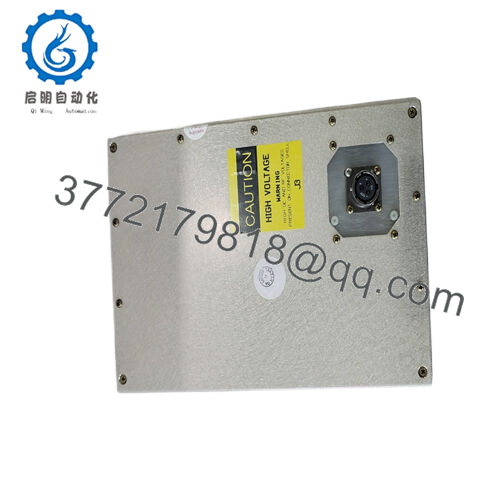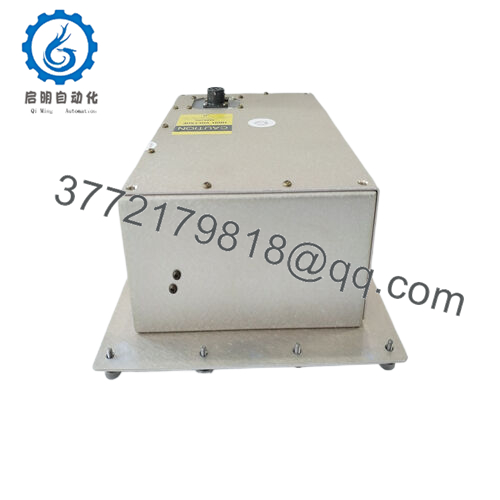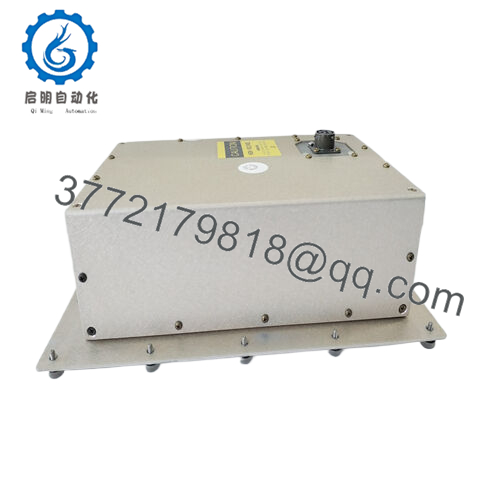Description
Product Model: ECC1-1
Product Brand: TRAZAR
Product Series / Category: Control / Electronic Control Unit (ECU)
Product Features:
- Modular design supporting analog, digital, and communication I/O
- Compact footprint tailored for integration into industrial systems
- High reliability under harsh conditions (–20 °C to +60 °C operating)
- Real-time control, data acquisition, diagnostics & HMI capability
- ECC1-1
Applications & Industry Context
In advanced automation settings — from semiconductor manufacturing to general industrial control — the demand for compact, scalable, and robust control modules is ever-present. The ECC1-1 module by TRAZAR serves this niche as a flexible electronic control unit (ECU), bridging field sensors/actuators with supervisory control systems.
In semiconductor fabrication, where precision, cleanliness, and tight control loops are mandatory, the ECC1-1 is often used in deposition, etching, or wafer-handling subsystems. Its ability to process digital and analog signals, support communications, and perform local control logic makes it well-suited to those exacting environments.
Outside of semiconductors, the ECC1-1 finds service in process automation, laboratory instrumentation, test equipment, or industrial machinery. Whenever you need a compact ECU that can function reliably in a hermetic enclosure, instrument rack, or control cabinet, ECC1-1 fits well.
In retrofit scenarios, it’s especially valuable: replacing aging analog control boards with a modular ECC1-1 allows modern I/O, diagnostics, and communications to be added without redesigning the entire machine.
The ECC1-1 also may serve in research or scientific instrumentation setups — where reliable signal processing and modular expansion (analog/digital/comm channels) are required in small-scale environments.
So, whether in fabs, pilot plants, or control consoles, the model functions as a control and data interface backbone — invisible but essential.
Technical Features & Benefits
While detailed vendor documentation is sparse, descriptions of ECC1-1 outline key features that align with industrial expectations. Here are the likely capabilities and engineering advantages, enriched with practical insight:
- Modular I/O Architecture
The ECC1-1 is reported to support digital I/O, analog I/O, and various communication interfaces (RS-485, CAN) in a modular layout. This flexibility allows users to tailor the module to the exact combination of measurement and control channels they need. - Compact and Space-Efficient
One of its selling points is its compact footprint — designed to fit into tight spaces or instrument stacks, saving panel real estate. - Harsh Environment Tolerance
The operating temperature is stated as –20 °C to +60 °C — suitable for many industrial settings. Also, its design is said to be stable in “harsh industrial environment” conditions over time. - Data Acquisition & Real-Time Processing
The ECC1-1 is described as performing not just I/O but also logic, data acquisition, and fault diagnostics, enabling it to act as a mini control node in systems. - Communications & Interface Support
The unit supports communication over RS-485 or CAN, enabling integration with SCADA, PLCs, or distributed networks. - High Reliability & Stability
Because it is marketed for industrial and semiconductor sectors, the ECC1-1 is engineered for long-term stability, low failure rates, and predictable performance under stress. - Customizable Logic & Expansion
Its modular design suggests that custom expansions or variant I/O mixes can be accommodated — ideal for OEMs needing tailored configurations.
From an engineering standpoint, these features mean that using ECC1-1 offers:
- Reduced wiring complexity by combining multiple signal types in one module
- Faster commissioning because much logic can be localized
- Better diagnostics and fault localization thanks to embedded processing
- Upgradability as I/O needs evolve
Overall, it trades some of the power of a full PLC for a more compact, specialized, and lower-cost control module — appropriate in many edge or subsystem cases.
Technical Specifications
Below is a speculative specification matrix based on available descriptions and typical industry expectations. Use with caution; verify exact values with datasheets.
| Specification | Description / Estimate |
|---|---|
| Model | ECC1-1 (TRAZAR) |
| Type | Electronic Control Unit (ECU) / Control Module |
| I/O Support | Digital I/O, Analog I/O, communication channels |
| Communication Interfaces | RS-485, CAN (optional or built-in) |
| Operating Temperature Range | –20 °C to +60 °C |
| Power Supply | Industrial low-voltage (model dependent; not publicly published) |
| Memory / Data Storage | ~1 MB data memory (cited in descriptions) |
| Response / Update Rate | Modular, real-time processing; likely < ms-level response (vendor claims “high reliability & stability”) |
| Dimensions / Footprint | Compact format (size not publicly disclosed) |
| Mounting | Panel or rack mount, modular enclosure, or DIN-style (assumed) |
| Certifications / Ratings | Industrial grade (shock, vibration, EMI tolerance) — not publicly confirmed |
| Module Weight | Not published in sources |
| Expansion Capability | Modular I/O expansion possible via plug-in modules |
Because many of these details are not published, it’s critical in design projects to request full datasheets from TRAZAR or your supplier for precise voltage ranges, isolation, response times, environmental certs, and mechanical drawings.
Product Role & System Fit
The ECC1-1 functions as a control & interface building block in broader automation systems. It occupies the mid-tier between field devices (sensors / actuators) and supervisory control (PLCs / SCADA). Its position is similar to what you’d expect of remote I/O modules with embedded logic.
In a typical industrial architecture:
- Field-level sensors (temperature, pressure, flow, digital inputs) connect to the ECC1-1’s I/O channels.
- The ECC1-1 processes and conditions these signals, executes local logic or diagnostic routines, and passes data to a PLC or control system over RS-485 or CAN.
- It may also output control commands (digital or analog) to actuators, valves, relays, or motors via local I/O.
- When integrated over multiple ECC1-1 units, a distributed control network emerges — each module responsible for a subsystem.
This modular architecture permits scalable, distributed control — essential in large systems or when incremental upgrades are desired. Because ECC1-1 handles I/O and logic locally, it reduces network traffic and ensures faster response times for critical loops.
In retrofit or hybrid systems, ECC1-1 can work alongside existing PLCs, replacing obsolete I/O racks without rewriting entire control logic. That flexibility is very attractive in long lifecycle industrial plants.
Installation & Maintenance Insights
Installing and maintaining an ECC1-1 module demands engineering care to preserve its performance, longevity, and reliability. Here are recommended practices:
- Mounting & Layout
Mount the ECC1-1 in a vibration-isolated rack or cabinet. Leave clearance for airflow and wiring access. Avoid placing it near high-power electronics or heat sources that could degrade temperature-sensitive electronics. - Power & Grounding
Use a stable, clean supply (often low-voltage DC). Proper grounding and shielding are critical — ensure signal and power grounds are well-managed to minimize noise pickup in analog/digital lines. - I/O Wiring & Shielding
Route analog and digital signal cables away from high-current or switched power cables. Use shielded twisted-pair wiring and terminate shields properly per manufacturer guidance. Avoid star-connected multiple shield terminations unless specified. - Configuration & Calibration
Upon first installation, configure I/O mapping, scaling, thresholds, fault handling, and communication parameters. Run point-by-point calibration to ensure analog channels deliver accurate readings. - System Integration Tests
Before full operation, simulate fault conditions, trip events, sensor failure, and confirm that logic, alarm, and shutdown paths behave as intended. Test communication interfaces to the upper-level system. - Routine Inspection & Cleaning
Periodically inspect connectors for corrosion, check for dust or debris in ventilation, and re-verify I/O integrity. Clean with dry compressed air, avoiding harsh chemicals that might degrade coatings. - Firmware & Diagnostic Monitoring
If firmware updates are available, apply them as recommended (outside of production hours). Use any built-in diagnostic or status LEDs/logging to monitor health over time (e.g., detect error counts, drift, communications latency). - Replacement & Spare Strategy
Maintain a backup ECC1-1 module configured with baseline settings. In systems requiring high uptime, design swappable modules or quick changeovers to minimize downtime.
Implemented properly, ECC1-1 can run for many years with minimal interventions — often becoming a “set it and forget it” part of a subsystem.





 WhatsApp: +86 16626708626
WhatsApp: +86 16626708626 Email:
Email:  Phone: +86 16626708626
Phone: +86 16626708626


